The colorful Mexican Turbo Snail, with its unique algae-eating efficiency is the ultimate reef-safe tank cleaner. This article will teach you how to create an environment conducive to giving your turbo snails a long, healthy life while they serve as a low-maintenance cleaning crew in your saltwater aquariums.

Introduction
Getting a marine algae eater is the most natural way to keep your reef tank clean, but do you know other species beyond fish have this trait? If you want to diversify your community, let me introduce you to the Turbo snail.
Like many snail species, the Turbo snail has multiple variants, but today, we’re focusing on Turbo Fluctuosa. It’s the largest Turbo Snail species with a preference for cold water.
Turbo fluctuosa‘s cleaning benefits come from this snail’s voracious algae-eating diet suitable for maintaining clean reef setups. That paired with this snail’s peaceful temperament makes the Turbo Snail perfect for community saltwater aquariums.
To add this 3-inch large herbivore to your tank, you’ll need this Turbo snail care guide to maximize its 3-year lifespan.
Author’s Note: Check out these 20 Hair Algae Eaters for a SPOTLESS Aquarium for more hard working algae eaters!
Recognizing the Turbo Snail: A Unique Reef Inhabitant
Identifying Turbo snails starts with their physical appearance. They have thick, rounded shells and a strong sucker they use to navigate their natural habitat of rocky reefs. You can also distinguish each species by using its size, coloration, and unique habits.
Color Patterns

Turbo snails grow to a max of between 1 – 3 inches, with the Mexican Turbo being the largest.
They often have neutral shell colors ranging from grayish-green to olive, brown, and tan, but that’s not the kicker. These patterns on their shells and color mixtures really draw your attention.
These marine snail shell patterns vary from marbled to spiral bands. They also appear smooth or rough depending on their genetics and environment.
You’ll also love the different colors of Turbo snail bodies and suckers, from light gray to beige, off-white, light brown, and spotted black or dark gray marks.
Unique Traits
Once the striking shell patterns captivate you, you can appreciate the Mexican Turbo snail’s unique traits. Why is this species “reef-safe”? They are considered safe for reef tanks because they are herbivores with their primary food source being algae, meaning they primarily graze on unwanted algae growth in a reef tank without actively harming corals.
However, their size and movements can mean they accidentally displace corals, more on managing this later. For now, let’s discuss the ideal environment for this reef-safe algae-eater.
Setting Up the Ideal Tank for Turbo Snails

When designing a Turbo Snail tank setup that is perfect for the Turbo fluctuosa species, this section will come in very handy. So, what is the ideal marine snail habitat to suit the Mexican Turbo Snail’s water preference and larger size? Check it out, up next!
Tank Layout
Our next task is to get a tank that holds at least 30 gallons of water per small group of 2-3 because the Mexican Turbo snail needs enough space to move and surfaces for algae growth. Next, we’ll design a reef-safe environment filled with live rock and varied surfaces for grazing like their natural habitat
Water Parameters
Mexican Turbo snails prefer cold water, so lean toward the lower recommended temperature. Stick to alkaline water because acidic environments will cause shell erosion.
| Temperature | 72 – 75℉ |
| pH | 8 – 8.4 |
| Salinity | 1.023 – 1.026 |
| Hardness | 8 – 16dKH |
| Calcium | 380 – 450 ppm |
To maintain pristine water conditions we recommend one of these 8 Best RO DI Systems For a Reef Tank which is a water filtration system designed to produce highly purified water by removing almost all contaminants from tap water.
Decor Essentials
Now, it’s time for the reef tank essentials to make your pet comfortable and beautify your aquarium. Get live plants, rocks, smooth surfaces for easy movement, and corals for algae growth to encourage exploration and their natural feeding habits.
Author’s Note: Check out our article on the Best LED Aquarium Lighting for Reef Tank Corals for a comprehensive guide on setting up your saltwater aquarium.
Feeding Turbo Snails: A Natural Algae Solution
Marine snail nutrition is typically herbivorous, and Mexican Turbo snails prefer natural algae growth. They’ll only eat alternative food sources when algae levels in the tank run low.
Diet Suggestions
Use these Turbo fluctuosa diet tips when feeding this species,
- As staples, serve them macroalgae, hair algae, biofilm, and diatoms.
- Supplement their diet with seaweed sheets, algae wafers, and blanched vegetables as treats.
Feeding Tips
When feeding Turbo Snails, always monitor the natural algae levels to prevent food scarcity. As long as algae is present, your pets will graze daily without your help. But if they’re living on supplements, always remove uneaten food 24 hours after to prevent water contamination.
Compatible Tank Mates for Turbo Snails
Turbo snails are perfect for community tanks because of their peaceful nature. They’ll live in harmony with other reef-safe invertebrates if they’re compatible. So avoid aggressive or predatory tank mates even if they’re reef-safe. Check out our article on the 15 Reef Safe Saltwater Fish for more tankmate ideas!
Compatible Species

Some compatible marine species include peaceful reef fish like Clownfish and Tangs, shrimps like peppermint and Fire shrimp, and other invertebrates like Nerite snails, Astrea turbo snails, and some Hermit crabs. But be careful because Hermit crabs can be shell thieves.
Avoided Species

Non-compatible Turbo Snail tank mates that’ll stress your pets or even eat them include:
- Aggressive Hermit crabs, like the blue-legged species that will steal their shells.
- Predatory fish like Puffers and Triggers who eat snails.
Breeding Turbo Snail: The Best Tank Setup For Reproductive Success
Breeding Turbo Snails in home aquariums is rare because they’re outside their natural habitat. However, if you recreate the right spawning conditions, you can achieve Turbo snail reproduction success.
Breeding Tank Setup
Ensure you have a well-established tank filled with live marine plants and coral reefs with lots of surfaces for algae growth and provide proper oxygenation to prepare your pets for reproduction.
Use the exact specifications as their living conditions with warmer water at 75 – 80℉. Feed them enough calcium and algae while making frequent significant water changes of at least 50%.
Egg and Larvae Care
Turbo snails have a unique breeding behavior called broadcast spawning, where they release their eggs and sperm into the water at the same time, causing spontaneous fertilization. The fertilized eggs form Turbo Snail Larvae, also known as veligers which are pelagic (free-swimming) larva, and drift for weeks before maturing.
Here is a great short video of the Mexican Turbo Snail’s broadcast spawning process,
As veligers grow into tiny snails, they’ll settle on smooth rocks and graze biofilm or algae growing out of them for nutrition, upon which you may now treat them as adults.
Lifespan and Long-Term Care for Turbo Snails
If you follow these Reef-safe invertebrate care tips, from building the ideal habitat to serving the right diet and mixing them with compatible companions, your Mexican Turbo snail can live for up to 3 years.
Lifespan Factors
Turbo Snail lifespan care is how you maintain stable water conditions, feed them a proper herbivorous diet, and treat them in case of illness. Avoid copper-based treatments because they’ll be harsh on the Turbo snail’s shell and cause damage.
Care Tips for Longevity
Providing optimal conditions for the lifespan factors is the first step in ensuring their long life and good health. Long-term marine snail health is when you turn it into a habit by practicing regular tank maintenance and monitoring your pets for stress signs.
It’ll help you know when to treat your pets and maintain pristine water conditions by changing ¼ of the water every week.
Managing Turbo Snail Behavior and Movement Challenges

I know I told you Turbo snails have strong suckers to prevent displacement in strong currents, but I must warn you that this pet can be clumsy. They’ll fall over and struggle to right themselves if you don’t help them and may inadvertently knock over decor.
So, here are practical tips for managing marine snail fails:
Behavior Tips
Understand that Mexican Turbo Snails have heavier rounder shells, which may be too heavy to move. They may also knock over loose decor like corals or rocks when grazing and displace them into dangerous positions for their movement.
They’ll move slowly or fall over from inactivity when stressed or hungry.
Preventing Falls
Use these Turbo Snail movement tips and prioritize reef tank safety for snails to manage their clumsiness.
- Secure every decor in the layout
- Place them on stable surfaces
- Check for upside-down snails and place them upright.
- Avoid strong water currents by using our recommended powerheads for a more natural flow in your reef tank.
- Maintain optimal conditions to prevent stress.
Scroll to the top and ensure you understand this care guide to provide your pets with the ultimate lifestyle.
Preventing Common Health Issues in Turbo Snails

You can tell the common health issues Turbo snails face from the behavior tips I just covered. They may experience shell erosion, starvation, and stress due to poor acclimation, but you can avoid these issues with proper Turbo snail health care.
Preventative Measures
This overview is already a Turbo fluctuosa wellness guide on preventing marine snail diseases. So as mentioned provide stable water conditions instead of sudden water changes, practice gradual acclimation, and provide sufficient food.
Signs of Illness
Watch your pets for symptoms like inactivity, shell deterioration, or excessive mucus production. Inactivity results from hunger, stress, or parasitic sickness, while shell deterioration or excessive mucus is a sign of poor water conditions and infection.
In case of illness, change the water, ensure optimal parameters, improve their diet, and if needed visit a vet.
Conclusion
Turbo Snails are perfect reef-tank algae control pets because of their voracious eating habits. But there are more reasons to keep this species in your aquarium. They’re peaceful, efficient, and low-maintenance, as is clear in the Turbo snail care essentials section we covered.
You can achieve Turbo fluctuosa aquarium success by following the care tips outlined in this article. Do your part while they do theirs and create magic together.
Join our community and share your experience in the comment section below.


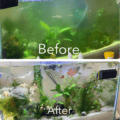
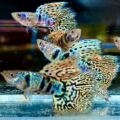
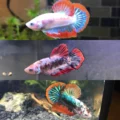
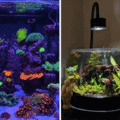


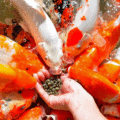
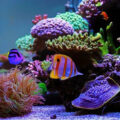

Why can’t I keep snails alive in my marine aquarium. Its almost 2 yrs old. Frequent (2 x )month water change. Temp 78-80